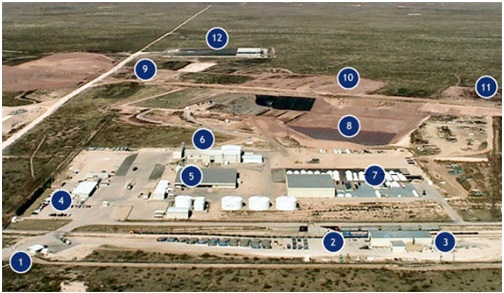
Blog
-
Geiger Readings for August 26, 2014
My Geiger counter is in the shop for maintenance. -
Radioactive Waste 91 – Texas Waste Facility Wants To Expand Intake of Radioactive Wastes from Other States
What to do with nuclear waste is one of the big open questions with respect to nuclear power and nuclear weapons production. The United States spent over a decade preparing for a geological repository at Yucca Mountain in Nevada before the project was cancelled in 2009. Now the best estimate for a permanent nuclear waste repository is 2050. The repository was primarily intended for spent nuclear fuel which is quickly filling up all available temporary storage at nuclear reactor sites. There is a geological repository for nuclear waste generated by nuclear weapons production call the Waste Isolation Pilot Plant near Carlsbad, New Mexico. It had operated for fifteen years before an unexpected release of particles of plutonium and americium closed the repository. It may never reopen.
Texas legalized private nuclear waste dumps in 2003. The only existing such dump in Texas is the Waste Control Specialist’s Facility (WCSF) low level nuclear waste dump in Andrews County. The dump can accept just about any type of nuclear waste. All radionuclides are welcome at the dump including plutonium which has a half life of hundreds of thousands of years. All components of nuclear reactors such as containment vessels, piping, sludge, and other residues can be stored there with the exception of spent nuclear fuel rods. One location was licensed to accept up to two million three hundred thousand cubic feet of waste. (11 on photo below) Another location was licensed to accept twenty six million cubic feet of radioactive waste from federal facilities. (10 on photo below) A third location has been designated for up to thirty thousand cubic feet of “by-product” waste which includes uranium mine tailings and yellow cake as well as equipment. (9 on photo below) The WCSF also has licenses that would permit it to process and store transuranic waste.
The Lone Star Sierra Club has been attempting to appealed to the Texas Commission on Environmental Quality (TCEQ) but been denied the right to a hearing to appeal these licenses on the grounds of public health threat. The TCEQ has been very friendly to industry and hostile to environmental groups. It is usually staffed by polluting industry alumni appointed by the governor. Texas is one of the most polluted states in the U.S. with some of the most lax regulation.
When the WIPP was closed, drums of waste from Los Alamos National Laboratory were shipped there for temporary storage. It turns out that some of these drums may be generating enough heat to explode because mistakes were made with absorbent additives at the laboratory. These drums are not stored in a facility that can monitor for anomalous heat production or confine explosions.
Now the TEQC has decided that it will allow the WCSF in Andrews County to accept depleted uranium from federal energy facilities. They are raising the allow amount from two million three hundred thousand cubic feet to nine million cubic feet. Environmentalists are complaining about this expansion of waste capacity. Depleted uranium waste can become more radioactive over time and poses a long term threat to public health. There are concerns about the local geology and underground water sources near the waste dump. Critics say that the amounts and types of waste being accepted at the site keep growing. No public comments were allowed when the TEQC voted to raise the storage limit.
There have been many explosions, fires and releases of toxic materials in Texas due to the industry friendly lax or non-existent regulation of industry. One day, release of hazardous radioactive materials may be added to the environmental devastation of Texas.
Waste Control Specialist’s Facility:
-
Geiger Readings for August 25, 2014
My Geiger counter is in the shop for maintenance.
-
Radiation News Roundup August 24, 2014
Cracked Belgian reactors may be retired and the same risks exist at 22 nuclear plants worldwide. fukuleak.org
Scientist holds press conference in Tokyo to announce their very striking results show radiation injury to whole ecosystems. enenews.com
What can be done to reduce nuclear risks in volatile countries? nuclear-news.net
Japan’s “nuclear restart” fades into the doubtful future. nuclear-news.net
-
Geiger Readings for August 24, 2014
My Geiger counter is in the shop for maintenance.
-
Geiger Readings for August 23, 2014
My Geiger counter is in the shop for maintenance.
-
Nuclear Weapons 91 – Proposed U.S. Russian Aggression Prevention Act Would Increase Danger of Nuclear War
I have often posted articles about the threat of nuclear war. The United States and Russia each have thousands of nuclear missiles pointed at each other and ready to launch in minutes. Since the end of the Cold War, these facilities and launch systems have been in decline in both countries. Funds have been cut for maintenance and training has declined in quality. There have already been a couple of incidents since the end of the Cold War that almost resulted in nuclear war. With the seizure of Crimea by Russia, relations between the U.S. and Russia have cooled. Now members of the U.S. Congress are proposing a law that could move us closer to nuclear war with Russia.
Senator Bob Corker (R-Tenn) has introduced the Russian Aggression Prevention Act (RAPA) bill in the U.S. Congress. The bill “provides major non-NATO ally status for Ukraine, Georgia, and Moldova for purposes of the transfer or possible transfer of defense articles or defense services. In essence RAPA would make Ukraine, Georgia and Moldova de facto members of NATO. Under the provisions of this bill, the new non-NATO major ally status would allow the U.S. to move substantial weapons, supplies and troops into these countries without having to seek NATO approval. This is a crucial point because Germany has been strongly opposed to the U.S. request to make these countries official members of NATO.
When the Soviet Union fell, the Western powers make a deal with Russia and her neighbors. In return for removing nuclear weapons from countries in the old Soviet Union, NATO would not take countries that neighbored Russia in Easter Europe into NATO. This was also part of the negotiations to scale down the U.S. and Russian nuclear arsenals. Some members of the U.S. Congress would like to bring NATO to Russia’s doorstep. We here in the U.S. cannot imagine what it was like to be invaded by a neighboring country and have millions of its citizens slaughtered. Russia is understandably paranoid.
The civil war in Ukraine is already close to becoming a Ukraine-Russian war. If the U.S. moves troops and serious military hardware such as the Ballistic Missile Defense system into Ukraine, this will be seen as a major provocation by Russia. If Ukraine and Russia go to war in such a circumstance, it will be very difficult for the U.S. not to be drawn into the conflict. A state of war between the U.S. and Russia would result in nuclear forces in both countries going to high alert. Both countries have plans for pre-emptive nuclear strikes on the other country if it appeared that a nuclear attack was imminent. The possibilities for misunderstandings and accidents triggering a full scale nuclear war would be raised. As I have said often before, a full scale nuclear war would be the end of human civilizations and lead to the death of billions of people. This bill is a very bad idea that would make a dangerous international situation much worse.
Senator Bob Corker (R-Tenn)

